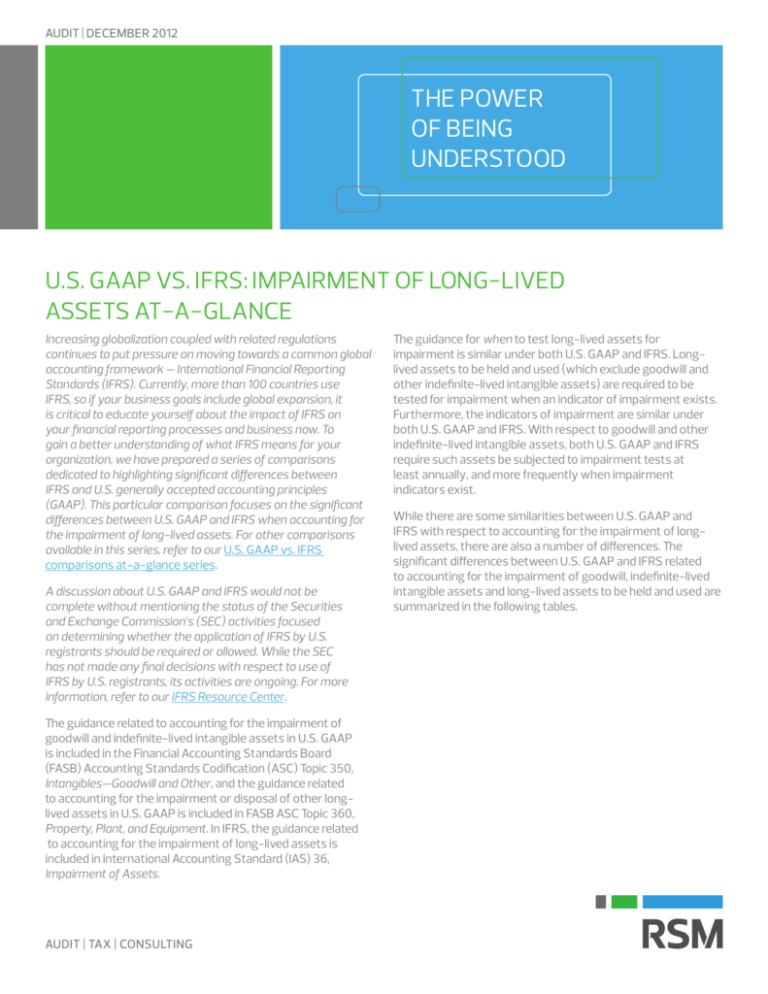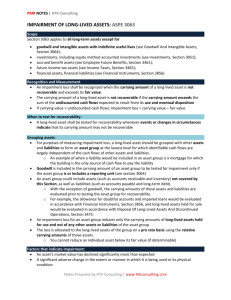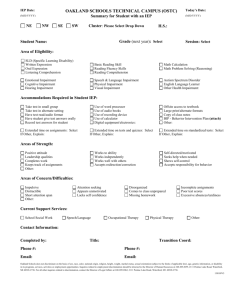
AUDIT | DECEMBER 2012
THE POWER
OF BEING
UNDERSTOOD
U.S. GAAP VS. IFRS: IMPAIRMENT OF LONG-LIVED
ASSETS AT-A-GLANCE
Increasing globalization coupled with related regulations
continues to put pressure on moving towards a common global
accounting framework – International Financial Reporting
Standards (IFRS). Currently, more than 100 countries use
IFRS, so if your business goals include global expansion, it
is critical to educate yourself about the impact of IFRS on
your financial reporting processes and business now. To
gain a better understanding of what IFRS means for your
organization, we have prepared a series of comparisons
dedicated to highlighting significant differences between
IFRS and U.S. generally accepted accounting principles
(GAAP). This particular comparison focuses on the significant
differences between U.S. GAAP and IFRS when accounting for
the impairment of long-lived assets. For other comparisons
available in this series, refer to our U.S. GAAP vs. IFRS
comparisons at-a-glance series.
A discussion about U.S. GAAP and IFRS would not be
complete without mentioning the status of the Securities
and Exchange Commission’s (SEC) activities focused
on determining whether the application of IFRS by U.S.
registrants should be required or allowed. While the SEC
has not made any final decisions with respect to use of
IFRS by U.S. registrants, its activities are ongoing. For more
information, refer to our IFRS Resource Center.
The guidance related to accounting for the impairment of
goodwill and indefinite-lived intangible assets in U.S. GAAP
is included in the Financial Accounting Standards Board
(FASB) Accounting Standards Codification (ASC) Topic 350,
Intangibles—Goodwill and Other, and the guidance related
to accounting for the impairment or disposal of other longlived assets in U.S. GAAP is included in FASB ASC Topic 360,
Property, Plant, and Equipment. In IFRS, the guidance related
to accounting for the impairment of long-lived assets is
included in International Accounting Standard (IAS) 36,
Impairment of Assets.
AUDIT | TAX | CONSULTING
The guidance for when to test long-lived assets for
impairment is similar under both U.S. GAAP and IFRS. Longlived assets to be held and used (which exclude goodwill and
other indefinite-lived intangible assets) are required to be
tested for impairment when an indicator of impairment exists.
Furthermore, the indicators of impairment are similar under
both U.S. GAAP and IFRS. With respect to goodwill and other
indefinite-lived intangible assets, both U.S. GAAP and IFRS
require such assets be subjected to impairment tests at
least annually, and more frequently when impairment
indicators exist.
While there are some similarities between U.S. GAAP and
IFRS with respect to accounting for the impairment of longlived assets, there are also a number of differences. The
significant differences between U.S. GAAP and IFRS related
to accounting for the impairment of goodwill, indefinite-lived
intangible assets and long-lived assets to be held and used are
summarized in the following tables.
IMPAIRMENT OF GOODWILL
U.S. GAAP
IFRS
Relevant guidance
ASC 350
IAS 36
Goodwill allocation
Goodwill is allocated to a reporting unit.
Depending on the facts and circumstances, a
reporting unit is either an operating segment
or one level below an operating segment
(which is also referred to as a “component”).
Goodwill is allocated to a cash-generating unit
(CGU). A CGU is the smallest identifiable group
of assets that generates cash flows that are
largely independent of the cash flows from
other assets or groups of assets. A CGU cannot
be larger than an operating segment.
Recognition of
impairment loss
An impairment loss is recognized when the
carrying amount of the reporting unit (unless
the carrying amount is zero or negative) is
greater than its fair value (Step 1) and the
carrying amount of goodwill is greater than
its implied fair value (Step 2). When the
carrying amount of a reporting unit is zero or
negative, an impairment loss is recognized
when a qualitative assessment indicates
that it is more likely than not that a goodwill
impairment exists and the carrying amount of
goodwill is greater than its implied fair value.
A one-step approach compares the carrying
amount of a CGU (including goodwill) to its
recoverable amount. When the carrying
amount of a CGU is greater than its recoverable
amount, an impairment loss is recognized. The
“recoverable amount” is the greater of: (a) the
fair value less costs to sell and (b) the value in
use (i.e., the present value of future cash flows
expected to be derived from the CGU).
Prior to performing Step 1, entities may
elect to perform a qualitative assessment
of whether it is more likely than not that the
carrying amount of a reporting unit exceeds
its fair value. If the qualitative assessment
indicates that it is more likely than not that the
carrying amount of a reporting unit exceeds
its fair value, then Step 1 must be performed.
If the opposite is true, the impairment test
is complete.
Measurement of
impairment loss
The impairment loss is the amount by which
the carrying amount of goodwill exceeds its
implied fair value in the reporting unit.
The impairment loss is the amount by which the
carrying amount of the CGU (including goodwill)
exceeds its recoverable amount. That loss is
then allocated first to goodwill, until goodwill is
reduced to zero. The carrying amounts of other
assets in the CGU are then reduced, on a prorata basis (subject to certain exceptions).
Reversal of
impairment loss
Prohibited.
Prohibited.
IMPAIRMENT OF INDEFINITE-LIVED INTANGIBLE ASSETS
U.S. GAAP
IFRS
Relevant guidance
ASC 350
IAS 36
Unit of account
In general, the unit of account is an
individual asset. However, in rare cases,
the unit of account may be a combined
group of separately-recorded indefinitelived intangible assets that are essentially
inseparable from one another.
When possible, the impairment test should be
carried out at the individual asset level. If the
test cannot be performed at the individual asset
level, it should be performed at the CGU level.
Recognition and
measurement of
impairment loss
An impairment loss is recognized for the
amount by which the carrying amount of the
intangible asset exceeds its fair value.
An impairment loss is recognized for the
amount by which the carrying value of the
intangible asset exceeds its recoverable
amount. The “recoverable amount” is the
greater of: (a) the fair value less costs to sell
and (b) the value in use (i.e., the present value
of future cash flows expected to be derived
from the asset[s].)
An entity has the option to first assess
qualitative factors to determine whether it
is necessary to estimate the fair value of an
indefinite-lived intangible asset. An entity
electing this option only has to estimate
the fair value of an indefinite-lived intangible
asset if its qualitative assessment indicates
it is “more likely than not” that the asset
is impaired.
Reversal of
impairment loss
Prohibited.
For indefinite-lived intangible assets on which
an impairment loss has been recognized in the
past, an entity must perform an annual review
for indicators of reversal. If such an indicator
exists, the entity estimates the recoverable
amount of the asset(s) in question and
previously recognized impairment losses
are reversed up to the new recoverable
amount, subject to a ceiling of the initial
carrying amount.
IMPAIRMENT OF LONG-LIVED ASSETS TO BE HELD AND USED
U.S. GAAP
IFRS
Relevant guidance
ASC 360
IAS 36
Unit of account
The unit of account is an asset group, which
is defined under U.S. GAAP as “the lowest
level for which identifiable cash flows are
largely independent of the cash flows of other
groups of assets and liabilities.” An asset
group almost always includes multiple assets.
In other words, an asset group is rarely a
single asset.
When possible, the impairment test should be
carried out at the individual asset level. If the
test cannot be performed at the individual asset
level, it should be performed at the CGU level.
Recognition of
impairment loss
An impairment loss is recognized when the
carrying amount is greater than both the
undiscounted cash flows (recoverability test)
and fair value.
An impairment loss is recognized when
the carrying amount is greater than the
recoverable amount. The “recoverable amount”
is the greater of: (a) the fair value less costs
to sell and (b) the value in use (i.e., the present
value of future cash flows expected to be
derived from the asset[s].)
Measurement of
impairment loss
The impairment loss is the excess of the
carrying amount of an asset group over its
fair value.
The impairment loss is the excess of the
carrying amount of the asset over its
recoverable amount.
Reversal of
impairment loss
Prohibited.
For long-lived assets to be held and used on
which an impairment loss has been recognized
in the past, an entity must perform an annual
review for indicators of reversal. If such an
indicator exists, the entity estimates the
recoverable amount of the asset(s) in question
and previously recognized impairment losses
are reversed up to the new recoverable
amount, subject to a ceiling of the initial
carrying amount adjusted for depreciation.
These are the significant differences between U.S. GAAP
and IFRS with respect to accounting for the impairment of
long-lived assets. Refer to ASC 350 and 360 and IAS 36 for
all of the specific requirements applicable to accounting for
the impairment of long-lived assets. Refer to our Snapshot:
Accounting for the impairment of goodwill and other longlived assets for additional discussion of U.S. GAAP. Refer to
our U.S. GAAP vs. IFRS comparisons at-a-glance series for
more comparisons highlighting other significant differences
between U.S. GAAP and IFRS.
Contact:
Richard Stuart, Partner
National Accounting Standards Group, RSM US LLP
+1 203 905 5027
richard.stuart@rsmus.com
+1 800 274 3978
www.rsmus.com
This document contains general information, may be based on authorities that are subject to change, and is not a substitute for professional advice or services. This document does not constitute audit, tax, consulting,
business, financial, investment, legal or other professional advice, and you should consult a qualified professional advisor before taking any action based on the information herein. RSM US LLP, its affiliates and related
entities are not responsible for any loss resulting from or relating to reliance on this document by any person. RSM US LLP is a limited liability partnership and the U.S. member firm of RSM International, a global network
of independent audit, tax and consulting firms. The member firms of RSM International collaborate to provide services to global clients, but are separate and distinct legal entities that cannot obligate each other. Each
member firm is responsible only for its own acts and omissions, and not those of any other party. Visit rsmus.com/aboutus for more information regarding RSM US LLP and RSM International. RSM® and the RSM logo
are registered trademarks of RSM International Association. The power of being understood® is a registered trademark of RSM US LLP.
© 2015 RSM US LLP. All Rights Reserved.
IS_AS_0915_IFRS Impairment of Long Lived Assets







